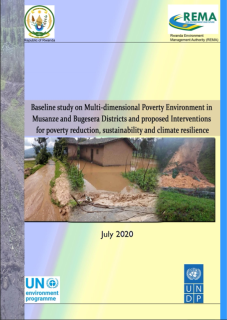
Tremendous efforts are being deployed by the Government of Rwanda to deal with poverty. Currently, 38.2% and 16% of the population live in poverty and extreme poverty respectively. Statistics indicate that approximately 70% of the total population earns their livelihoods from rain-fed subsistence agriculture (National Institute of Statistics Rwanda (NISR), 2015a); whereas 13% of households in Rwanda have experienced cases of environmental problems, most of them (57%) were pertaining to heavy and destructive rains (National Institute of Statistics Rwanda (NISR), 2018a.) This is an indication that the natural resource base and its contribution to economic growth and poverty reduction is under pressure, due to the imbalance between the population and the natural resources especially in rural areas (Ministry of Finance and Economic Planning (MINECOFIN), 2020). This situation is aggravated by the high vulnerability caused by the undulating terrain, susceptibility to erosion and climatic hazards.
This baseline study was conducted to comprehensively document poverty-environment levels in Bugesera and Musanze Districts. It had the following three objectives: (1) Multi-dimensional poverty-environment assessment, and proposal for effective Poverty Environment mainstreaming in both Districts; (2) Proposed inclusive and sustainable poverty-environment interventions which address both poverty reduction and environment-natural resource management, and provide opportunities for the private sector and other partners to effectively contribute to sustainability and poverty reduction; and (3) Proposed scale-up plan and practical implementation of the same or similar interventions to other Districts in the country.
To achieve the objectives of the present study, mixed methods triangulation design consisting of both qualitative and quantitative approaches. The quantitative data was collected using household (HH) survey questionnaire administered to a total of 224 households for Bugesera District and 231 households for Musanze District, and desk review through which secondary data was collected. Primary qualitative data was collected through Focus Group Discussions (FGDs) and interviews for key informants with 92 and 36 participants respectively in Bugesera District; and 96 and 35 participants respectively in Musanze District. Poverty levels were assessed by applying the combination of Environmental and Natural Resources (ENR) and Multidimensional Poverty Index (MPI) methodologies to measure the ENR-MPI for both Districts. Thereafter, ENR dimensions (soil, water, forest, fishery, and mining) were linked to poverty dimensions (standard of living, health and education), after which chi-square and correlation tests were computed to show the contributions of ENRs indicators to poverty dimensions.
